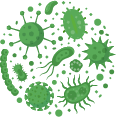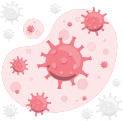Definition
Goiter is the enlargement or swelling of the thyroid gland in children. Located in the neck, a goiter appears as an enlarged thyroid visible externally.
The thyroid gland is located at the front of the neck, beneath the skin and muscles. In men, it is situated below the Adam's apple. The gland is reddish-brown and consists of two lobes that resemble butterfly wings.
It is a small endocrine gland responsible for producing thyroid hormones, which regulate various body functions including growth, energy management, and sexual development. Hormones are chemical compounds that can send signals to their target organs in the body and affect the activity of that part of the body. These hormones regulate various functions in the body.
Goiter may present as one or multiple nodules in the thyroid gland, or as a general enlargement of the thyroid gland. This condition may result in the thyroid gland producing excessive thyroid hormone (hyperthyroidism) or insufficient amounts (hypothyroidism), though an enlarged thyroid gland can also generate thyroid hormone within normal ranges. Abnormalities in the thyroid gland can have significant consequences for children.
Causes
Goiter in children can be congenital (present at birth) or acquired later in life. Common causes include thyroid disorders like inflammation, infection, cysts, tumors, or cancer, although the latter are rare in children.
Congenital Goiter
Causes of congenital goiter include:
- A genetic disorder that inhibits the infant's thyroid gland from synthesizing thyroid hormone appropriately.
- An infant with either a singular side (lobe) or a partial thyroid gland, resulting in the gland's enlargement as a compensatory mechanism to satisfy the body's requirement for thyroid hormone.
- The mother experiences a thyroid disorder in her pregnancy. In instances of Graves' disease, antibodies from the mother may occasionally traverse the placenta to the fetus. This condition can influence the fetal thyroid gland, leading to the production of either excessive or insufficient thyroid hormone by the fetal thyroid gland.
- The expectant mother consumes medications that are capable of crossing the placenta and impacting the fetal thyroid gland, such as the antiarrhythmics amiodarone or methimazole used to manage the mother's hyperthyroid condition.
Acquired Goiter
Meanwhile, causes of acquired goiter include:
- Hashimoto's Thyroiditis
An autoimmune condition where the immune system attacks thyroid cells, leading to chronic inflammation and reduced hormone production.
- Graves' Disease
This condition is the most prevalent cause of goiter associated with elevated levels of thyroid hormones (hyperthyroidism) in children and adolescents. Eighty percent of instances of Graves' disease occur after the child reaches the age of 11. In infants, this condition is uncommon, but it may be life-threatening if not addressed.
The immune system targets the thyroid gland, resulting in inflammation and excessive thyroid hormone production. This condition can also lead to inflammation and swelling in the vicinity of the eyes.
- Iodine Deficiency in Diet
This phenomenon is rare, particularly in developed nations due to the widespread use of iodized salt. Nevertheless, the majority of cases of goiter accompanied by hypothyroidism globally are attributed to insufficient daily iodine intake.
- Infection
- Viral or bacterial infections can cause thyroid inflammation and enlargement.
- Cysts, Tumors or Cancer
The development of cysts or fluid-filled sacs within the thyroid gland may lead to the occurrence of goiter. While uncommon in pediatric patients, both benign and malignant tumors of the thyroid can similarly result in goiter.
- Colloid Goiter
Occasionally, the thyroid gland may enlarge during puberty. Nonetheless, this phenomenon is regarded as normal and does not invariably signify hypothyroidism or hyperthyroidism. Typically, the thyroid gland functions adequately, and its size will revert to normal as one ages, without necessitating any treatment.
Risk Factor
Risk factors for developing goiter in children include:
- Family history of thyroid disorders.
- Maternal use of certain medications during pregnancy.
- Inadequate dietary iodine.
- Female gender, due to hormonal changes.
Symptoms
In congenital goiter, the thyroid enlargement is usually firm and symmetrical. Most children do not experience pain, although some might feel discomfort. The thyroid may enlarge partially or entirely, and a visible lump may move up and down while swallowing. Children can also complain of the sensation of something clogged or stuck in the throat.
Many children with goiters have thyroid glands that function normally. However, certain children may experience either hypothyroidism or hyperthyroidism. Additional symptoms that may be observed, aside from neck enlargement, are typically contingent upon the specific disorder, whether it is hypothyroidism or hyperthyroidism. Symptoms related to thyroid function abnormalities include fatigue, skin problems, temperature intolerance, weight changes, and activity issues.
Diagnosis
Goiter is frequently identified by families and physicians during visual inspection and palpation of the neck. Blood tests and ultrasound of the thyroid gland can provide physicians with insights into potential abnormalities in children. An ultrasound is conducted to determine the dimensions of the thyroid gland. Concurrently, blood tests are utilized to evaluate the concentration of thyroid hormone in the bloodstream, it is referred to as a thyroid function test.
If the test reveals a nodule (localized lump on the thyroid), additional investigation is typically warranted. Should the physician suspect that the lump in the child is a tumor or malignancy, a tissue sample from the lump may be obtained for further laboratory analysis.
Management
Management of goiter are tailored according to the diseases causing it, including the child’s age and whether the thyroid gland is functioning normally. Depending on the outcomes of the assessment, the physician might suggest observing the lump for a period of time and not initiating treatment. This is particularly true if the goiter remains small and does not lead to any issues. Any alterations in the neck or thyroid gland should be discussed again with a physician.
Treatment for goiter will be fitted to treat the potential cause, such as hormone therapy and, in some cases, surgery. If a child is administered levothyroxine in instances where the thyroid gland fails to produce sufficient hormones, the child is advised against consuming iron, calcium, stomach antacids, and simethicone while on the medication.
Surgical interventions are carried out if the thyroid gland continues to grow despite treatment and leads to difficulties in breathing or swallowing.
Complications
Goiter itself typically does not cause serious complications but can lead to breathing and swallowing difficulties if it becomes too large.
Prevention
Preventing iodine deficiency is key to avoiding goiter. A diet including iodized salt, fish, and dairy products can help maintain adequate iodine levels.
When to See a Doctor?
It's important to seek medical attention if a child has a neck swelling, persistent neck pain, difficulty swallowing, or a change in voice. Early diagnosis and treatment can prevent complications and manage symptoms effectively.
Looking for more information about other diseases? Click here!
- dr Hanifa Rahma
Calabria, A. (2022) Congenital goiter - children's health issues, MSD Manual Consumer Version. MSD Manuals. Available at: https://www.msdmanuals.com/home/children-s-health-issues/hormonal-disorders-in-children/congenital-goiter (Accessed: January 9, 2023).
Gannon, A.W. (ed.) (2018) Goiters and thyroid nodules (for parents) - nemours kidshealth, KidsHealth. The Nemours Foundation. Available at: https://kidshealth.org/en/parents/goiter.html (Accessed: January 9, 2023).
Thyroid disorders: Manifestations, evaluation, and management in children and adolescents (2019) Contemporary Pediatrics. Available at: https://www.contemporarypediatrics.com/view/thyroid-disorders-manifestations-evaluation-and-management-children-and-adolescents (Accessed: January 9, 2023).








